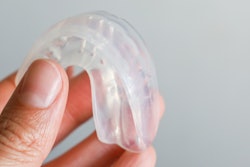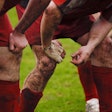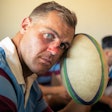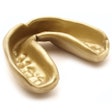
Dental trauma in sports may be more common than you think. To further develop injury prevention strategies, researchers investigated dental injury rates in young athletes playing medium- and high-risk sports, as well as the players' awareness and use of strategies to minimize them.
The investigators surveyed participants on water polo, karate, taekwondo, and handball teams about their dental injuries and prevention strategies. Among the results, they found that athletes often did not wear mouthguards, and oral injury rates in the medium-risk sports of handball and water polo were higher than expected (Dental Traumatology, March 11, 2018).
"It is important to raise awareness of sports-related dental injuries in young athletes, even in sports that have not been considered high-risk," lead study author Tea Galic, DMD, PhD, told DrBicuspid.com. "Lots of such injuries can be prevented by using a mouthguard, so they should be offered to all athletes, not only in high-risk sports."
Dr. Galic is an assistant professor of dental medicine in the University of Split School of Medicine in Croatia.
Knocked out
The risk of orofacial and dental trauma has been growing as sports participation has increased among children and adolescents, according to previous research. Additionally, sports-related dental accidents are responsible for one-third of dental injuries in adults and children.
The International Dental Federation has classified sports such as American football, ice hockey, skateboarding, rugby, and mountain-biking as high-risk sports and basketball, soccer, team handball, water polo, and gymnastics as medium-risk ones, the study authors noted.
Most sports-related dental injuries can be prevented by wearing a mouthguard, but they are not widely accepted among athletes. Some high-risk sports require that players wear mouthguards, which has been shown to be beneficial regarding dental injuries.
In the current study, the authors sought to compare the frequency of dental injuries in high- and medium-risk sports, as well as the habits and attitudes of athletes regarding mouthguards and other preventive measures, to develop strategies for reducing sports-related dental trauma.
They recruited 240 athletes who participated in water polo, karate, taekwondo, or handball to complete a questionnaire. Of the 60 athletes per sport given the questionnaire, 229 completed it, for a 95% response rate. Of the 229 respondents, 59 (25.8%) participated in water polo, 58 (25.3%) in karate, 57 (24.9%) in taekwondo, and 55 (24%) in handball.
The athletes ranged in age from 5 to 19, with an average of 12.9 years, while 157 (68.6%) were male and 72 (31.4%) were female. Their average playing experience was 4.8 years.
For their study, the researchers defined orofacial injuries as facial bone fractures, soft-tissue injuries, a combination of soft-tissue and dental injuries, and dental injuries, such as a crown fracture, tooth luxation, and avulsion.
Of the 229 athletes, 58 (25.3%) had experienced orofacial injuries, with 16 of them sustaining multiple orofacial injuries either as a combination of soft-tissue and dental injuries or as separate injuries occurring on multiple occasions.
The frequency of orofacial injuries was lower in taekwondo (8/57, 14%) than in water polo (17/59, 28.8%), karate (17/58, 29.3%), and handball (16/55, 29%), but it was not significantly different (p = 0.163). Soft-tissue injuries (n = 22) were the most common orofacial injury, followed by dental injuries (n = 17).
Sports-related dental injuries were experienced by 31 (13.5%) athletes. Participants in water polo, karate, and handball reported higher rates of dental injuries than in taekwondo (p = 0.035).
| Dental injuries by type of injury in each sport | ||||||
| Water polo (n = 59) |
Karate (n = 58) |
Taekwondo (n = 57) |
Handball (n = 55) |
Total (n = 229) |
p-value | |
| Crown fracture | 4 (6.8%) | 1 (1.7%) | 0 (0) | 4 (7.3%) | 9 (3.9%) | 0.113 |
| Tooth luxation | 2 (3.4%) | 4 (6.9%) | 0 (0) | 4 (7.3%) | 10 (4.4%) | 0.192 |
| Avulsion | 5 (8.5%) | 5 (8.6%) | 2 (3.5%) | 4 (7.3%) | 16 (7.0%) | 0.681 |
| Total | 11 (18.6%) | 10 (17.2%) | 2 (3.5%) | 12 (21.8%) | 35 (15.3%) | 0.035 |
"We did expect a high rate of injuries in karate and taekwondo, but the occurrences of tooth injuries in medium-risk sports, such as handball and water polo, was unexpected," Dr. Galic told DrBicuspid.com.
Regarding knowledge of injury treatment, 83 athletes (36.2%) knew that an avulsed tooth could be replanted, and 104 (45.4%) had heard of a tooth rescue box, a special physiological storage medium for the avulsed tooth that can improve the prognosis for sports-related dental injuries, with greater knowledge of the latter in those who had experienced dental injuries.
Only 94 of the 229 athletes (41%) reported wearing a mouthguard during sports activities, even though 223 (97.3%) were aware of mouthguards for dental trauma prevention and considered them efficient for injury prevention (215/229, 93.9%). Significantly more of those who considered mouthguards to be unnecessary had not experienced dental trauma (44.4% versus 4.4%, p < 0.001).
Significantly more taekwondo (42/57, 73.7%) and karate (41/58, 70.7%) participants used mouthguards than handball (8/55, 14.5%) and water polo (3/59, 5.1%) players (p < 0.001). The most common reason given for not wearing a mouthguard was that it was unnecessary (50/135, 37%), followed by its being uncomfortable (21.5%).
The most common dental injury was avulsion, which can cause serious periodontal damage with lifelong effects, so the authors advised that coaches and other sporting officials be educated about emergency procedures following avulsion. They also recommended greater availability of tooth rescue boxes at sports facilities and competitions.
They argued for the reclassification of sports based on dental trauma risk since the medium-risk sports of handball and water polo had similarly high rates of dental trauma as karate, which is classified as a high-risk sport.
"It would be beneficial to make wearing a mouthguard mandatory in all high-risk sports, as well as those with medium risk for dental injuries," they wrote.
Lack of objective measures
The study's main limitation was its use of a self-administered questionnaire, which may not accurately report objective findings, the authors noted.
Dr. Galic and his colleagues are conducting further research on sports-related dental injuries and hope to use their results to create a sports-related injury prevention program.
So how might dentists help to reduce dental and orofacial sports injuries?
"Dentists should be aware of patient's participation in sports, and they should introduce them to prevention measures to protect their stomatognatic system," Dr. Galic told DrBicuspid.com. "Dentists should try to participate in sports teams as a team dentist, at least in their community, and in that way raise the knowledge about early prevention and treatment of sports-related dental injuries."



















